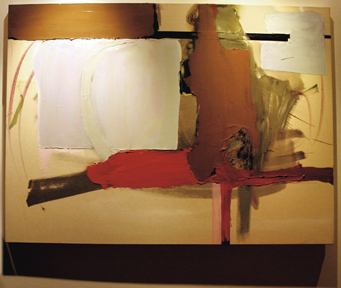PAINTER GLENN GARVER is not only an artist, he’s an adventurer. Garver ventured from New York to Jersey City before gentrification was even a twinkle in anybody’s eye. A 1984 graduate of the School of Visual Arts, he found himself crashing at places on the Lower East Side until he and his brother and a friend decided to take a road trip through the Holland Tunnel—and the rest is history.
“We were driving along the waterfront from Hoboken,” Garver remembers. “There were fields and empty lots, old rail yards, just open territory. It was a no man’s land, where you could see great views of New York, and then we were roaming around and stumbled on downtown Paulus Hook, which was a real neighborhood. There was a bar on every corner, a little six-block oasis right on the waterfront with the Colgate factory down the street.”
The three guys rented a duplex on Sussex Street for $600, which is where Garver set up his first studio, in the basement. He supported himself doing carpentry work—everything from hanging sheetrock to high-end renovations, woodwork, custom-made furniture, and winding banisters. He also worked on tugboats. “Bella’s pool hall, where the Light Horse now is, was filled with old tugboat captains,” he says.
When Garver moved to Morris Street in the early 1990s, he got a studio on 4th Street off Newark Avenue. He soon bought the tenement house he was living in and the one behind it, which were separated by a courtyard. For a while he was painting in the back building until he completely renovated it to accommodate his growing family.
“After 25 years of working in the trades, I finally had a chance to build something for myself,” Garver says. “Surroundings are important. I want them to be as calm and comfortable as possible.”
He now paints in a studio at Neumann Leather in Hoboken.
WHEN HE WAS IN COLLEGE, Garver’s work was representational. “I was doing nocturnal landscapes and imagery based on memories from childhood road trips,” he says. After studying with Michael Goldberg, a second-generation abstract expressionist, Garver’s work became more abstract, and he came to admire Pollock, DeKooning, and, most of all, Philip Guston.
“My representational work took on abstract elements, such as blocks of color,” Garver says. “I drifted away from the desire to paint something that had a place or time, and the horizon line just left me. But the internal feeling of what makes a painting click did not change.”
Like most visual artists, Garver says he has a hard time articulating exactly what he does or how he does it. “Looking at a painting is like listening to a piece of music,” he says. “What is it in the combination of notes that creates something? When I’m working on a painting it’s all from my gut. I don’t come to it from a preconceived idea of what imagery works. I know when I see it that it works—the combination of colors and shapes speaks to you.” Garver says that he waits to feel the same spark in his own paintings that he sometimes feels in looking at the work of successful painters he admires. “I know when to stop, when I’ve hit it—I don’t want to overwork it or try too hard—but I’m always curious to know if I will have another that will work as well. I wish I knew what it is that happens,” he says. “That is the great mystery.” JCM
glenngarver.com
